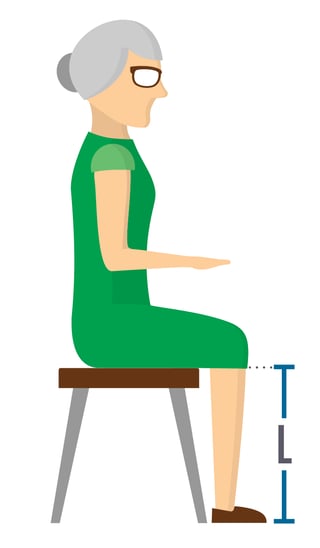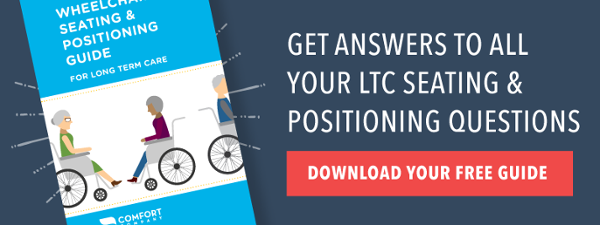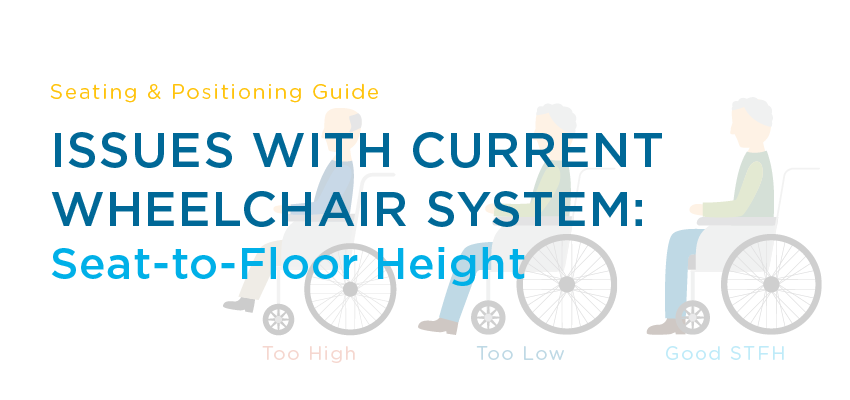Part 10 in our LTC Seating & Positioning series intended to shed some light on the mystery of seating and positioning in the LTC setting. See Part 1, Part 2, Part 3, Part 4, Part 5, Part 6, Part 7, Part 8, Part 9. Looking for more information on seating and positioning? Check out our digital, rehab-focused Wheelchair Seating & Positioning Guide here.
Why Measuring Matters
To fit a patient for the optimal seating system, many key measurements must be taken to ensure the wheelchair matches the patient’s very personalized dimensions. One problem we face in many settings, especially the nursing home and hospital settings, is trying to fit patients with various shapes and sizes into the standard 16 x 16” wheelchair we often are asked, for cost reasons, to use.
However, we need to consider that two people, 5 feet 7 inches tall, weighing 140 pounds can have completely different compositions, requiring two differently sized wheelchairs. One individual may have very short legs and a long torso while the other person has very long legs and a short torso. One thing I can guarantee you is that both will not fit into the same 16 x 16” wheelchair with its standard 21” achievable seat-to-floor height (STFH).
We as therapists need to always consider the functional goals of our patients:
- Do they need to self-propel?
- Will they use the lower extremities (LEs) to do so?
Self-propulsion using the LEs makes proper STFH critical and the appropriate measurement needs to be taken. And the measurement to ensure appropriate STFH is LOWER LEG LENGTH!

How to measure seat-to-floor-height (STFH, aka lower leg length):
- Measure from the top of the resident's seat to the floor (top of cushion if applicable)
- Measure with feet on floor with shoes that they normally wear or barefoot if they do not normally wear shoes, and measure bottom of foot/shoe to popliteal fossa
By understanding the lower leg length needed to achieve a proper heel strike for LE propulsion, you can choose the most appropriate wheelchair model according to its standard achievable STFH.
The chart below is a quick reference to match lower leg length to wheelchair model for proper seat-to-floor height
| Wheelchair Model | Achievable STFH | Lower Leg Length Required to Fit MWC |
| K0001 | 21" | 23" or longer |
| K0002 | 19" | 21" or longer |
| K0003 | 17" - 19" | 19" or longer |
| K0004 | As low as 14.5" | 16.5" or longer |
| K0005 | Completely Customizable | Any lower leg length |
TOO HIGH, TOO LOW? SO WHAT?

Without proper STFH, negative results in the wheelchair system can arise. If the STFH is too high, it is very probable the patient will slide forward to allow his foot to make contact with the floor for better heel strike. This promotes a posterior pelvic tilt also known as sacral sitting and leads to:
- Increased pressure on the bony prominences, resulting in a pressure injury
- Increased risk to fall from the wheelchair system
- Poor pelvic, trunk and LE alignment, increasing the risk of contractures.
When STFH is too low, the patient’s LEs can drag and get caught under the wheelchair during propulsion or transport. Patients can easily:
- Be thrown out of the front of the chair
- Sustain injury to knees, ankles and feet
In addition to these two commonly seen repercussions mentioned above, the charts below break down more seat-to-floor height issues due to incorrect wheelchair STFH.
|
SEAT-TO-FLOOR HEIGHT: TOO LOW
|
||
| What is going on? | Negative Result | What can you do? |
|
Leg rests are shortened to compensate for lack of threshold clearance Knees are then higher than the hips causing decreased femoral contact with the seat surface and LEs "sweep" to one side |
Windswept positioning of LEs |
Measure lower leg length Use a higher profile cushion Find a cushion with medial abduction and lateral adduction contours to maintain LE alignment |
| Keens higher than hips increase peak pressure at ITs, sacrum, and coccyx | Wound risk at ITs, sacrum, and coccyx |
Measure lower leg length Use a higher profile cushion Look for skin protection cushion that immerses and/or offloads the bony prominences |
| On a chair without leg rests, feet can drag and get caught under chair during propulsion or transport | Resident can be thrown out of chair or injury to LEs can occur |
Measure lower leg length Use a higher profile cushion |
|
SEAT-TO-FLOOR HEIGHT: TOO HIGH
|
||
| What is going on? | Negative Result | What can you do? |
| Foot propulsion is more difficult so resident slides forward for better strike | Posterior pelvic tilt aka sacral sitting |
Measure lower leg length Use a lower profile cushion |
| Increased pressure at distal thigh, increasing risk of LE edema, resident slides forward to reduce numbness and pain | Posterior pelvic tilt aka sacral sitting |
Measure lower leg length Use a lower profile cushion |
| Resident rotates forward on one side for better heel strike of one foot | Pelvic rotation |
Measure lower leg length Use a lower profile cushion |
| Feet "dangle" | Increased internal rotation and adduction of hip |
Measure lower leg length Use a lower profile cushion Find a cushion with medial abduction and lateral adduction contours to maintain LE alignment |
| Resident slides forward to alleviate strain on pelvis and knees | Posterior pelvic tilt aka sacral sitting |
Measure lower leg length Use a lower profile cushion |
*Choose a higher or lower profile cushion to compensate for incorrect STFH when switching out the MWC just isn't an option
The solution to improper STFH seems too easy, right? But it truly is that easy: measure lower leg length and match a wheelchair model that can achieve the STFH your patient needs. However, in settings where buying a higher end model manual wheelchair is too costly, sometimes choosing a higher or lower profile cushion to compensate for incorrect STFH can be the solution.
Hopefully this blog has brought to light some negative consequences that may arise because of improper STFH. Now we can begin to understand this is an important measurement that cannot be overlooked when choosing the optimal wheelchair for maximum function.
Please refer to the Seating and Positioning Guide to see what measurements need to be taken to ensure an accurately fitted wheelchair system!


Ana Endsjo, MOTR/L, CLT
Clinical Education Manager LTC Division
Ana Endsjo has worked as an occupational therapist since 2001 in a variety of treatment settings. She has mainly worked with the geriatric population, dedicated to the betterment of the treatment of the elderly in LTC centers. Her focus has been on seating and positioning and contracture management of the nursing home resident. With this experience, her hope is to guide other therapists, rehab directors, nurses, and administrators through educational guides, blogs, webinars, and live courses in her role as Clinical Education Manager for the long term care division.
